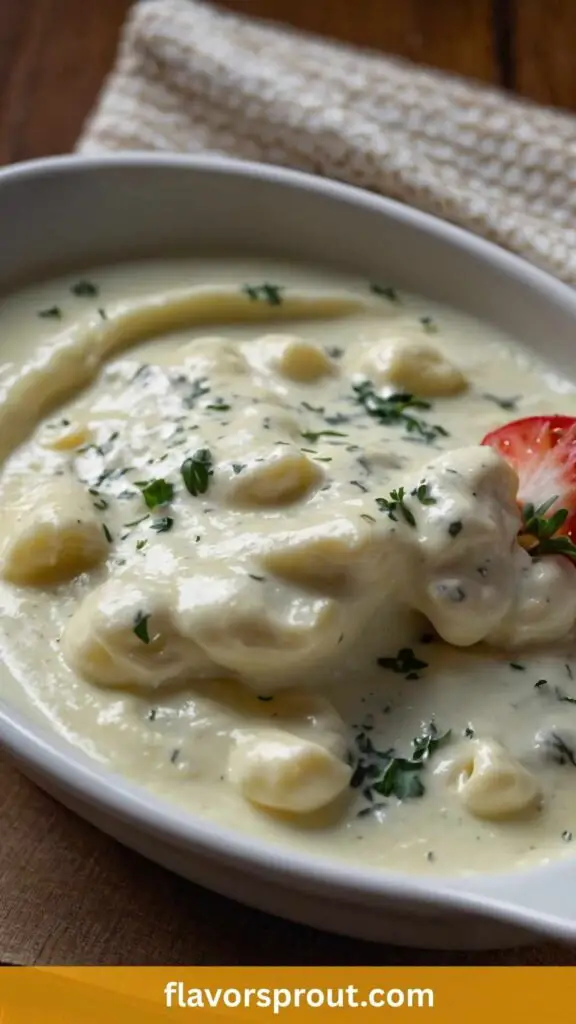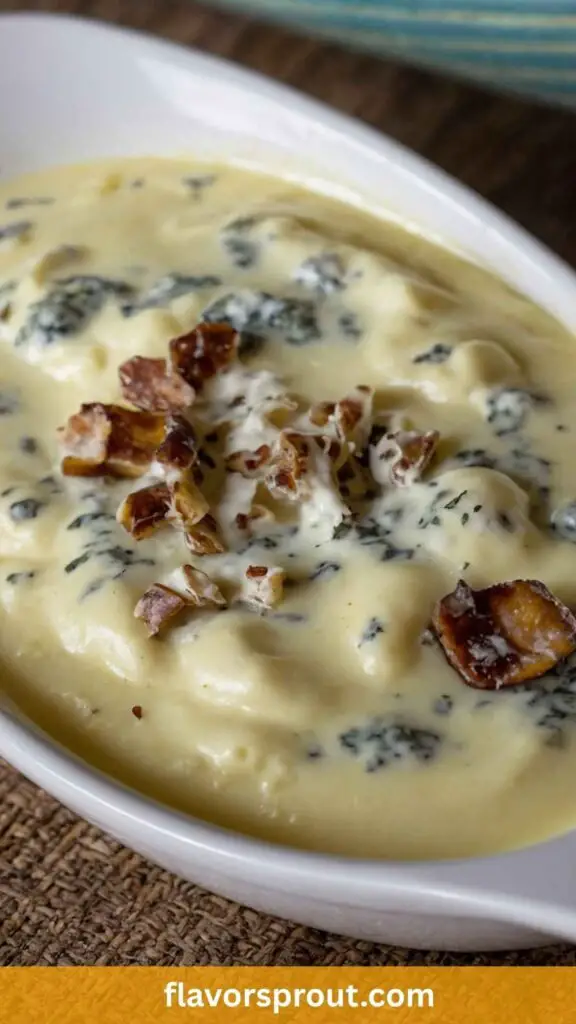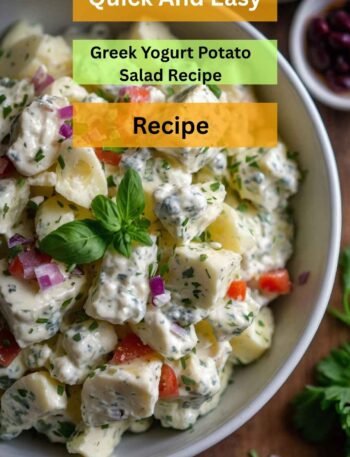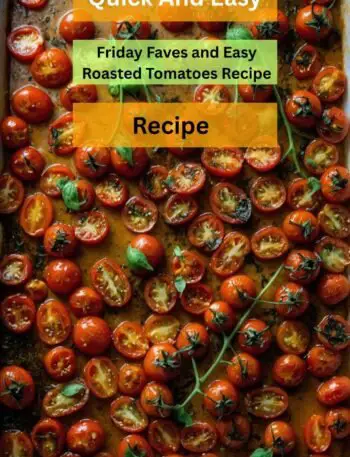When you’re in the kitchen, seeking to elevate a dish from ordinary to extraordinary, béchamel is your secret weapon. This creamy, rich sauce can transform countless recipes.
Picture lasagna oozing with layers of béchamel, or a delightful mac and cheese that wraps around your taste buds like a comforting hug. Trust me on this one; béchamel is the unsung hero of many beloved dishes.

You’ll Also Like These Recipes
- Pairing Suggestions for Cheesy French Onion Soup Recipe
- Buttery Parsley Potatoes
- Greek Yogurt Potato Salad
So, What Can You Pair With Béchamel?
Let’s kick things off with a thought-provoking question: what makes a dish remarkable? For me, it’s pairing flavors and textures. Béchamel sauce is incredibly versatile. You can generously drizzle it over roasted vegetables for a creamy finish, or use it as the base for decadent mac and cheese. Want a twist? Try it with seafood for a delightful gratin.
You can mix it into soups for extra body or layer it in lasagna alongside vegetables like spinach or mushrooms.
If summer is knocking at the door, consider using béchamel in a chilled pasta salad. Imagine the taste bud party that ensues with cold fusilli pasta, colorful veggies, and that signature creaminess. With so many possibilities, it’s hard to ignore the delightful nature of this sauce.
Introduction
Allow me to introduce you to béchamel. Known as “white sauce,” it’s one of the classic French “mother sauces.” I still remember the first time I tried making this sauce; the aromas wafting through the kitchen had me convinced I was a culinary wizard.
With just three ingredients—milk, flour, and butter—you can whip up this creamy delight in no time. But let’s put aside the scientific elements and delve deeper into what béchamel truly is.
What is Béchamel?
Béchamel, at its core, is a simple white sauce made by cooking flour and butter (that’s roux) and then whisking in milk. The magic happens as it thickens, creating a silky, velvety texture perfect for elevating a dish. Some might believe it’s just a mundane sauce, but let me tell you: béchamel is the backbone of several recipes across various cuisines. From Italy to France, this white sauce is the backbone of culinary greatness.
The process of making béchamel might seem uncomplicated, yet the pivotal moments happen in the details. You’ve got to watch carefully as the flour and butter come together; too little cooking time can yield a raw flour taste, while too much can lead to something more akin to cement. There’s a balance to strike, akin to learning a delicate dance. The end result? A sauce that’s creamy, soothing, and versatile—all without breaking a sweat.
How Does It Taste?
So, what’s the flavor profile? Béchamel is subtle yet impactful. It has a creamy mildness, often seasoned with just a pinch of salt and perhaps a hint of nutmeg. When made properly, béchamel is blank canvas that begs for creativity.
Picture creamy lasagna swathed in luscious layers of béchamel or a gratin topped with a golden-brown crust formed from bubbling cheese. The possibilities are endless, leaving your palate begging for more.
Why You’ll Love This
You might be wondering, “Why should I fall in love with béchamel?” Here are a few reasons:
Simplicity: With just a handful of ingredients, you can craft a sauce that feels lavish.
Versatility: From lasagna to casseroles, its applications are numerous.
Make Ahead: You can prepare it ahead of time and store it in the fridge or freezer.
A Touch of Luxury: Adding béchamel to your meals introduces an element of indulgence that impresses guests.
Nutritional Boost: With the right seasonings, it’s a creamy, comforting addition that doesn’t sneak in loads of calories.
Ingredients
Before we dive into the depths of cooking, let’s gather our ingredients. Here’s what you’ll need for a classic béchamel sauce:
- 1 quart whole milk
- ¼ cup plain all-purpose flour
- 5 tablespoons unsalted butter
- ½ teaspoon garlic powder
- 1 teaspoon fine sea salt, or to taste
- ¼ teaspoon white pepper
- ⅛ teaspoon freshly grated nutmeg, or to taste

Step by Step Directions
Let’s take those ingredients and turn them into a tantalizing béchamel sauce. Follow along, and I’ll guide you through each step.
Step 1: Melt the Butter
In a medium-sized saucepan, place the butter over medium heat. Watch as it melts, releasing a nutty aroma that fills your kitchen. Once melted, it’s time to whisk in the flour, creating that essential roux.
Step 2: Create the Roux
Continue whisking the butter and flour together for about 2–3 minutes. You want a blonde color; it shouldn’t be dark. This step is crucial to eliminate any raw flour taste while providing depth to the final sauce.
Step 3: Pour the Milk
Now, it’s time to add the milk. Gradually pour the warm milk into the roux while whisking vigorously. Step back and appreciate the way the mixture transforms as the milk is absorbed.
Step 4: Simmer and Thicken
Increase the heat slightly and cook the mixture while constantly stirring. You want to bring it to a gentle simmer. As it heats, the sauce will begin to thicken. Remember, whisking is your best friend here.
Step 5: Season the Sauce
Once your béchamel reaches the desired thickness, it’s time to season. Stir in garlic powder, salt, white pepper, and nutmeg. Adjust to your liking. A little taste test can go a long way here; it’s the moment where your béchamel becomes uniquely yours.
Step 6: Serve or Store
You can opt to use the béchamel immediately or store it. If saving for later, cover the surface with plastic wrap to prevent a skin from forming. Don’t worry; we’ll revisit it soon!
Tips On Making Béchamel
Making the perfect béchamel takes practice, but these tips will set you on the right path.
Use Gradually Warmed Milk: Cold milk can shock the roux and create lumps. Warm it slightly before adding.
Keep Whisking: Stirring continuously prevents lumps from forming and ensures a smooth consistency.
Check the Heat: Keep the heat at medium to avoid scorching the sauce. If it starts to boil vigorously, pull it off the burner momentarily.
Don’t Rush the Cooking: Allow the roux to cook until bubbly. This eliminates the raw flour taste, so take those few extra minutes.
Taste as You Go: Adjust seasoning to your palate. This is where béchamel becomes your culinary masterpiece.
Nutrition Information
Here’s a quick breakdown of nutritional information per serving (based on an approximate quarter-cup serving):
- Calories: 150
- Total Fat: 10g
- Saturated Fat: 6g
- Cholesterol: 30mg
- Sodium: 240mg
- Total Carbohydrates: 12g
- Protein: 4g
Béchamel provides a comforting balance of flavors while being mindful of portion control.
How Do You Store Béchamel?
If you’ve made too much béchamel (is there really such a thing?), here’s how to store it:
Refrigerate: Place the béchamel in an airtight container and refrigerate it for up to 3 days.
Freeze: For longer storage, portion it into freezer-safe bags, squeezing out excess air. You can conveniently pop it out when needed, good for up to 3 months.
Reheat Carefully: When reheating, add a splash of milk and whisk vigorously to restore that creaminess.

What Other Substitutes Can You Use in Béchamel?
If you’re looking to swap out some ingredients or get creative, consider these substitutes:
Almond Milk: For a dairy-free option, almond milk behaves similarly to cow’s milk in this sauce.
Gluten-Free Flour: Use a gluten-free flour blend in place of all-purpose flour for a gluten-free béchamel.
Nutritional Yeast: This can add a cheesy flavor while keeping it vegan. Combine with almond milk for creaminess.
Coconut Milk: For a richer, tropical twist, try coconut milk. This will yield a slightly sweeter, flavorful sauce.
Cashew Cream: Blend soaked cashews with water for a creamy alternative; this behaves beautifully in béchamel.

Béchamel
Equipment
- Saucepan
Ingredients
- 1 quart whole milk
- ¼ cup plain all-purpose flour
- 5 tablespoons unsalted butter
- ½ teaspoon garlic powder
- 1 teaspoon fine sea salt or to taste
- ¼ teaspoon white pepper
- ⅛ teaspoon freshly grated nutmeg or to taste
Instructions
Step 1: Melt the Butter
- In a medium-sized saucepan, place the butter over medium heat. Watch as it melts, releasing a nutty aroma that fills your kitchen. Once melted, it’s time to whisk in the flour, creating that essential roux.
Step 2: Create the Roux
- Continue whisking the butter and flour together for about 2–3 minutes. You want a blonde color; it shouldn’t be dark. This step is crucial to eliminate any raw flour taste while providing depth to the final sauce.
Step 3: Pour the Milk
- Now, it’s time to add the milk. Gradually pour the warm milk into the roux while whisking vigorously. Step back and appreciate the way the mixture transforms as the milk is absorbed.
Step 4: Simmer and Thicken
- Increase the heat slightly and cook the mixture while constantly stirring. You want to bring it to a gentle simmer. As it heats, the sauce will begin to thicken. Remember, whisking is your best friend here.
Step 5: Season the Sauce
- Once your béchamel reaches the desired thickness, it’s time to season. Stir in garlic powder, salt, white pepper, and nutmeg. Adjust to your liking. A little taste test can go a long way here; it’s the moment where your béchamel becomes uniquely yours.
Step 6: Serve or Store
- You can opt to use the béchamel immediately or store it. If saving for later, cover the surface with plastic wrap to prevent a skin from forming. Don’t worry; we’ll revisit it soon!
Notes
Keep Whisking: Stirring continuously prevents lumps from forming and ensures a smooth consistency.
Check the Heat: Keep the heat at medium to avoid scorching the sauce. If it starts to boil vigorously, pull it off the burner momentarily.
Don’t Rush the Cooking: Allow the roux to cook until bubbly. This eliminates the raw flour taste, so take those few extra minutes.
Taste as You Go: Adjust seasoning to your palate. This is where béchamel becomes your culinary masterpiece.
Nutrition
Frequently Asked Questions
1. Can I make béchamel in advance?
Absolutely! Béchamel can be made ahead of time and stored in the refrigerator for a few days or frozen for longer use.
2. What is the difference between béchamel and other sauces?
Béchamel is one of the five mother sauces in classical cooking. Unlike tomato or velouté sauces, béchamel is primarily milk-based and is used as the foundation for many creamy dishes.
3. Can I add cheese to béchamel?
Yes, adding cheese creates a delightful cheese sauce, often used for mac and cheese. Stir in shredded cheese until melted for a rich, cheesy flavor.
4. How can I avoid lumps in my béchamel?
To avoid lumps, ensure you’re whisking continuously when adding the milk, and always use warm milk.
5. What dishes can I use béchamel in?
Béchamel can be used in lasagna, mac and cheese, gratins, casseroles, and even in creamy soups.
6. Can I season my béchamel differently?
Certainly! Experiment with spices; garlic, onion powder, or even herbs such as thyme or rosemary can lend great flavors.
Conclusion
Béchamel has earned its stripes as a fundamental sauce in kitchens worldwide. It may start simply, but its applications are vast and exciting. With each step of preparation, you have the chance to create something truly delicious.
The next time you’re in the kitchen, give this rich sauce a whirl, and explore what culinary heights you can reach. Trust me; once you master this classic, the culinary world will open up in ways both delicious and surprising. So, roll up those sleeves and dive into the world of béchamel; it’s a creamy adventure you won’t regret.




